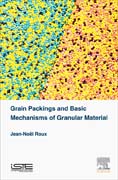
Simple model materials are favoured for modeling purposes. Connections to real?, more complex materials are stressed as often as possible, with references to experimental work. The mechanical properties are presented at different strain scales, and are explained, as far as possible, as one gets from one type of behaviour, suitable for one strain range, to another one. Thus, such questions are addressed as what is the role of contact deformability in the macroscopic stress-strain response or Does the slope of the stress-strain curve relate to elastic moduli? The first chapter is devoted to ingredients of a model on different scales, and the granular and colloidal nature of interactions across the grain and contacts. The second deals with granular assemblies static structure, dependence on manufacturing process, characteristics; and the possible role of cohesion. Chapter 3 deals with elasticity, elastic regime; instability and rupture of contact networks; and what is quasi-static evolution. Chapter 4 deals with the evolution of texture and internal variables; can we define the ingredients of a élastiplastique? model (criterion, flow rule, hardening). The last chapter deals with the microscopic and macroscopic properties of the attractor state under monotonic shearing; generalization to inertial flow; and relevance to the rheology of concentrated suspensions. Provides an understanding of the physical nature of granular mechanics Provides a guide on good practice of granular (discrete element) simulationProvides a cross-disciplinary approach INDICE: 1) Definitions and properties of a granular material2) Static Granular Assemblies3) Contact Network Mechanic4) Evolution of contact network through rearrangements and Elastroplasticity5) The Critical State and its generalizations
- ISBN: 978-1-78548-077-5
- Editorial: ISTE Press - Elsevier
- Encuadernacion: Cartoné
- Páginas: 250
- Fecha Publicación: 01/12/2016
- Nº Volúmenes: 1
- Idioma: Inglés
